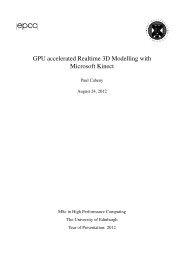Create successful ePaper yourself
Turn your PDF publications into a flip-book with our unique Google optimized e-Paper software.
GPUWattch + GPGPU-Sim:<br />
An Integrated Framework for Performance and<br />
Energy Optimizations in Manycore Architectures<br />
Jingwen Leng (The University of Texas at Austin)<br />
Tayler Hetherington (University of British Columbia)<br />
Version of simulator corresponding to these slides = GPGPU-‐Sim 3.2.1<br />
Website<br />
gpgpu-sim.org<br />
(/gpuwattch)
Tutorial Goals<br />
• Make you more effective in your research<br />
using GPGPU-Sim & GPUWattch<br />
§ Feel free to ask questions when you have them<br />
• After this tutorial, you will be able to:<br />
§ Describe what GPGPU-Sim simulates<br />
§ New: Describe what GPUWattch simulates<br />
§ Setup GPGPU-Sim/GPUWattch and<br />
run CUDA/OpenCL applications on it<br />
§ Extend GPGPU-Sim/GPUWattch for your own research<br />
April 2013 GPGPU-Sim/GPUWattch Tutorial (ISPASS 2013) 1.2
Quick Survey<br />
• How many of you are:<br />
§ Graduate students or Faculty members?<br />
§ Working for industry?<br />
• Have you written a CUDA or OpenCL<br />
program before?<br />
• Have you used GPGPU-Sim/GPUWattch?<br />
April 2013 GPGPU-Sim/GPUWattch Tutorial (ISPASS 2013) 1.3
Overview<br />
1 GPGPU-‐Sim | Brief Background on GPU CompuBng 40 min<br />
2 GPGPU-‐Sim | Overview 30 min<br />
3 GPUWaIch | Power Basics 20 min<br />
Coffee Break (10:00 – 10:30am)<br />
4 GPUWaIch | Details of GPUWaIch Modeling I 30 min<br />
5 GPUWaIch | Details of GPUWaIch Modeling II 35 min<br />
6 Demo: Setup and Run 15 min<br />
7 Wrap Up and Discussion 10 min<br />
Lunch (12:00 – 1:00pm)<br />
April 2013 GPGPU-Sim/GPUWattch Tutorial (ISPASS 2013) 1.4
What is a GPU?<br />
§ Optimized for Highly Parallel Workloads<br />
§ Highly Programmable<br />
§ Commodity Hardware (“Desktop Supercomputing”)<br />
§ 512 ALUs<br />
April 2013 GPGPU-Sim/GPUWattch Tutorial (ISPASS 2013)<br />
1.5
GPU Computing<br />
4 core CPU + 1536 core GPU<br />
§ Heterogeneous computing<br />
April 2013 GPGPU-Sim/GPUWattch Tutorial (ISPASS 2013)<br />
1.6
Why GPU?<br />
*Slide from GTC 2011, GPU Compu*ng: Past, Present and Future, David Luebke, NVIDIA<br />
April 2013 GPGPU-Sim/GPUWattch Tutorial (ISPASS 2013)<br />
1.7
Why GPU?<br />
*Slide from GTC 2011, GPU Compu*ng: Past, Present and Future, David Luebke, NVIDIA<br />
April 2013 GPGPU-Sim/GPUWattch Tutorial (ISPASS 2013)<br />
1.8
Why GPU?<br />
*Slide from AFDS 2011, The Programmer’s Guide to the APU Galaxy, Phil Rogers, AMD<br />
April 2013 GPGPU-Sim/GPUWattch Tutorial (ISPASS 2013)<br />
1.9
Why GPU?<br />
• OpenCL supported GPUs<br />
(besides AMD and NVIDIA)<br />
§ Adreno TM 3xx GPU from Qualcomm<br />
§ Mali TM -T600 Series GPUs from ARM<br />
§ HD 4000 on Intel’s Ivy Bridge<br />
§ Intel Xeon Phi (Knights Corner)<br />
• GPU Computing is gaining broad industry<br />
support.<br />
April 2013 GPGPU-Sim/GPUWattch Tutorial (ISPASS 2013) 1.10
Programming Model<br />
§ Producer / Consumer<br />
§ CPU offload data parallel code sections onto the<br />
GPU<br />
§ GPU = computation workhorse<br />
§ CPU = sequential code “accelerator” and I/O offload<br />
engine<br />
April 2013 GPGPU-Sim/GPUWattch Tutorial (ISPASS 2013)<br />
1.11
GPU Microarchitecture Overview<br />
(10,000 feet)<br />
GPU<br />
SIMT Core Cluster<br />
SIMT<br />
Core<br />
Memory<br />
ParEEon<br />
SIMT<br />
Core<br />
GDDR3/GDDR5<br />
SIMT Core Cluster<br />
SIMT<br />
Core<br />
InterconnecEon Network<br />
Memory<br />
ParEEon<br />
GDDR3/GDDR5<br />
SIMT<br />
Core<br />
Off-‐chip DRAM<br />
April 2013 GPGPU-Sim/GPUWattch Tutorial (ISPASS 2013)<br />
Single-‐InstrucBon, MulBple-‐Threads<br />
SIMT Core Cluster<br />
SIMT<br />
Core<br />
Memory<br />
ParEEon<br />
GDDR3/GDDR5<br />
SIMT<br />
Core<br />
1.12
CUDA and OpenCL<br />
§ This tutorial focus on CUDA<br />
• More applications today<br />
April 2013 GPGPU-Sim/GPUWattch Tutorial (ISPASS 2013)<br />
1.13
CUDA Thread Hierarchy<br />
• kernel = grid of blocks of warps<br />
of scalar threads<br />
• Thread blocks (CTAs) contains up<br />
to 1024 threads<br />
• Threads are grouped into warps<br />
in hardware<br />
SIMT Core<br />
Thread Block<br />
Thread Thread Block<br />
(CTA) (CTA)<br />
Block<br />
(CTA)<br />
32 Threads<br />
32 32Threads Threads<br />
32 32Threads Threads<br />
32 Threads<br />
32 32Threads Threads<br />
32 Threads<br />
Warps<br />
April 2013 GPGPU-Sim/GPUWattch Tutorial (ISPASS 2013)<br />
Source: NVIDIA<br />
Each block is dispatched to<br />
a SIMT core as a unit of<br />
work: All of its warps run in<br />
the core’s pipeline unBl<br />
they are all done.<br />
1.14
Warp = SIMT Execution of<br />
Scalar Threads<br />
• Warp = Scalar threads grouped to execute in lockstep<br />
• SIMT vs SIMD<br />
§ SIMD: HW pipeline width must be known by SW<br />
§ SIMT: Pipeline width hidden from SW (★)<br />
Thread Warp<br />
Scalar<br />
Thread<br />
W<br />
Scalar<br />
Thread<br />
X<br />
Scalar<br />
Thread<br />
Y<br />
Common PC<br />
Scalar<br />
Thread<br />
Z<br />
Thread Warp 3<br />
Thread Warp 8<br />
Thread Warp 7<br />
SIMT Pipeline<br />
(★) Can sBll write sobware that assumes threads in a warp execute in lockstep (e.g. see reducBon in NVIDIA<br />
SDK)<br />
April 2013 GPGPU-Sim/GPUWattch Tutorial (ISPASS 2013)<br />
1.15
SIMT Execution Model<br />
foo[] = {4,8,12,16};<br />
A: v = foo[tid.x];<br />
B: if (v < 10)<br />
C: v = 0;<br />
else<br />
D: v = 10;<br />
E: w = bar[tid.x]+v;<br />
A T1 T2 T3 T4<br />
B T1 T2 T3 T4<br />
C T1 T2<br />
D T3 T4<br />
E T1 T2 T3 T4<br />
April 2013 GPGPU-Sim/GPUWattch Tutorial (ISPASS 2013)<br />
Time<br />
1.16
CUDA Syntax Highlights<br />
__global__ void foo(...); // runs on GPU, callable from CPU<br />
__device__ void bar(...); // function callable from a GPU thread<br />
foo(...); // 500 blocks, 128 threads each<br />
dim3 threadIdx; dim3 blockIdx; dim3 blockDim;<br />
April 2013 GPGPU-Sim/GPUWattch Tutorial (ISPASS 2013)<br />
1.17
CUDA Example Code<br />
Standard C Code<br />
void saxpy_serial(int n, float a, float *x, float *y)<br />
{<br />
for (int i = 0; i < n; ++i)y[i] = a*x[i] + y[i];<br />
}<br />
// Invoke serial SAXPY kernel<br />
saxpy_serial(n, 2.0, x, y);<br />
High performance compuBng with CUDA, SC09 Tutorial, David<br />
Luebke, NVIDIA<br />
CUDA code<br />
__global__ void saxpy_parallel(int n, float a, float *x, float *y)<br />
{<br />
int i = blockIdx.x*blockDim.x + threadIdx.x;<br />
if(i
GPU Microarchitecture Overview<br />
GPU<br />
SIMT Core Cluster<br />
SIMT<br />
Core<br />
Memory<br />
ParEEon<br />
SIMT<br />
Core<br />
GDDR3/GDDR5<br />
SIMT Core Cluster<br />
SIMT<br />
Core<br />
InterconnecEon Network<br />
Memory<br />
ParEEon<br />
GDDR3/GDDR5<br />
SIMT<br />
Core<br />
Off-‐chip DRAM<br />
April 2013 GPGPU-Sim/GPUWattch Tutorial (ISPASS 2013)<br />
SIMT Core Cluster<br />
SIMT<br />
Core<br />
Memory<br />
ParEEon<br />
GDDR3/GDDR5<br />
SIMT<br />
Core<br />
1.19
Inside a SIMT Core<br />
SIMT<br />
Front End<br />
Fetch<br />
Decode<br />
Schedule<br />
Branch<br />
Done (Warp ID)<br />
Reg<br />
File<br />
SIMD Datapath<br />
Memory Subsystem Icnt.<br />
Network<br />
SMem L1 D$ Tex $ Const$<br />
§ Interleave warp execution to hide latency<br />
§ Register values of all threads stays in core<br />
April 2013 GPGPU-Sim/GPUWattch Tutorial (ISPASS 2013)<br />
1.20
Inside a SIMT Core (2.0)<br />
Schedule<br />
+ Fetch<br />
Decode<br />
§ Add extra stage for Register Read<br />
§ Add fine-grained multithreading<br />
§ Add SIMT stacks<br />
Register<br />
Read<br />
April 2013 GPGPU-Sim/GPUWattch Tutorial (ISPASS 2013)<br />
Execute Memory Writeback<br />
1.21
Inside a SIMT Core (3.0)<br />
SIMT Front End<br />
Branch Target PC<br />
Fetch SIMT-‐Stack<br />
Scheduler 1 Valid[1:N]<br />
I-‐Buffer<br />
I-‐Cache Decode<br />
Score<br />
Board<br />
Issue<br />
AcBve<br />
Mask<br />
Done (WID)<br />
Pred.<br />
§ Three decoupled warp schedulers<br />
§ Scoreboard<br />
§ Operand collector<br />
Scheduler 2<br />
§ Multiple SIMD functional unit<br />
Operand<br />
Collector<br />
April 2013 GPGPU-Sim/GPUWattch Tutorial (ISPASS 2013)<br />
SIMD Datapath<br />
Scheduler 3<br />
ALU<br />
ALU<br />
MEM<br />
1.22
CUDA Memory Model<br />
§ Local<br />
§ Shared<br />
§ Global<br />
§ Constant<br />
§ Texture<br />
April 2013 GPGPU-Sim/GPUWattch Tutorial (ISPASS 2013)<br />
Source: CUDA programming manual<br />
1.23
GPU Microarchitecture Overview<br />
GPU<br />
SIMT Core Cluster<br />
SIMT<br />
Core<br />
Memory<br />
ParEEon<br />
SIMT<br />
Core<br />
GDDR3/GDDR5<br />
SIMT Core Cluster<br />
SIMT<br />
Core<br />
InterconnecEon Network<br />
Memory<br />
ParEEon<br />
GDDR3/GDDR5<br />
SIMT<br />
Core<br />
Off-‐chip DRAM<br />
April 2013 GPGPU-Sim/GPUWattch Tutorial (ISPASS 2013)<br />
SIMT Core Cluster<br />
SIMT<br />
Core<br />
Memory<br />
ParEEon<br />
GDDR3/GDDR5<br />
SIMT<br />
Core<br />
1.24
Memory Partition<br />
• Service memory request (Load/Store/AtomicOp)<br />
§ Contains L2 cache bank, DRAM timing model<br />
§ Model Raster Operations Pipeline (ROP) latency<br />
April 2013 GPGPU-Sim/GPUWattch Tutorial (ISPASS 2013) 1.25
GPGPU-Sim in a Nutshell<br />
§ New: Power Model: GPUWattch<br />
April 2013 GPGPU-Sim/GPUWattch Tutorial (ISPASS 2013)<br />
1.26
Accuracy<br />
GPGPU-Sim IPC<br />
200<br />
150<br />
100<br />
RODINIA Benchmark Suite<br />
Quadro FX5800 SASS<br />
GPGPU-Sim 3.1.0 – Correlation: 98.37%<br />
50<br />
0<br />
Similarity Score<br />
copyChunks_kernel() Back Propaga*on<br />
bpnn_layerforward_CUDA()<br />
HotSpot<br />
calculate_temp()<br />
0 50 100 150 200<br />
Hardware IPC<br />
April 2013 GPGPU-Sim/GPUWattch Tutorial (ISPASS 2013)<br />
1.27
Accuracy<br />
GPGPU-Sim IPC<br />
500<br />
400<br />
300<br />
200<br />
100<br />
RODINIA Benchmark Suite<br />
Tesla C2050 (Fermi) SASS<br />
GPGPU-Sim 3.1.0 – Correlation: 97.35%<br />
0<br />
0 100 200 300 400 500<br />
Hardware IPC<br />
April 2013 GPGPU-Sim/GPUWattch Tutorial (ISPASS 2013)<br />
1.28
Accuracy (Average Power)<br />
EsEmated Power (W)<br />
250<br />
200<br />
150<br />
100<br />
50<br />
0<br />
NVIDIA GTX 480<br />
Average Absolute Error ≈ 12%<br />
0 50 100 150 200 250<br />
Measured Power (W)<br />
April 2013 GPGPU-Sim/GPUWattch Tutorial (ISPASS 2013) 1.29
Dependencies<br />
§ GCC, Make, etc.<br />
April 2013 GPGPU-Sim/GPUWattch Tutorial (ISPASS 2013)<br />
1.30
Citation<br />
Ali Bakhoda, George L. Yuan, Wilson W. L. Fung, Henry Wong, Tor M. Aamodt,<br />
Analyzing CUDA Workloads Using a Detailed GPU Simulator, In proceedings of the IEEE<br />
InternaBonal Symposium on Performance Analysis of Systems and Sobware (ISPASS),<br />
pp. 163-‐174, Boston, MA, April 26-‐28, 2009.<br />
§ E.g. “GPGPU-Sim version 3.2.1”<br />
April 2013 GPGPU-Sim/GPUWattch Tutorial (ISPASS 2013) 1.31
Citation<br />
Jingwen Leng, Syed Gilani, Tayler Hetherington, Ahmed El-‐Shafiey, Nam Sung Kim, Tor<br />
M. Aamodt, Vijay Janapa Reddi, GPUWaIch: Enabling Energy OpBmizaBon in GPGPUs,<br />
in ISCA 2013<br />
§ E.g. “GPUWattch version 1.0”<br />
April 2013 GPGPU-Sim/GPUWattch Tutorial (ISPASS 2013) 1.32
Session Summary<br />
• GPU Computing<br />
• CUDA Programming Model Concepts<br />
§ Thread Hierarchy<br />
§ Memory Spaces<br />
§ SIMT Execution Model<br />
• GPGPU-Sim:<br />
Timing + power simulator of modern GPUs<br />
§ Good accuracy<br />
§ Runs on systems without HW GPUs<br />
April 2013 GPGPU-Sim/GPUWattch Tutorial (ISPASS 2013) 1.33
Overview<br />
1 GPGPU-‐Sim | Brief Background on GPU CompuBng 40 min<br />
2 GPGPU-‐Sim | Overview 30 min<br />
3 GPUWaIch | Power Basics 20 min<br />
Coffee Break (10:00 – 10:30am)<br />
4 GPUWaIch | Details of GPUWaIch Modeling I 30 min<br />
5 GPUWaIch | Details of GPUWaIch Modeling II 35 min<br />
6 Demo: Setup and Run 15 min<br />
7 Wrap Up and Discussion 10 min<br />
Lunch (12:00 – 1:00pm)<br />
April 2013 GPGPU-Sim/GPUWattch Tutorial (ISPASS 2013) 1.34
Outline<br />
§ Functional model for<br />
PTX/SASS + CUDA/OpenCL<br />
§ Timing model for the compute part of a GPU<br />
§ New: Power model: GPUWattch<br />
April 2013 GPGPU-Sim/GPUWattch Tutorial (ISPASS 2013)<br />
2.35
Session Objective<br />
• After this session, you will be able to:<br />
1. Summarize what GPGPU-Sim simulates<br />
2. Describe how GPGPU-Sim interfaces with CUDA<br />
applications and supports SASS<br />
3. Summarize the advances between<br />
GPGPU-Sim 2.1.1b and 3.2.1<br />
April 2013 GPGPU-Sim/GPUWattch Tutorial (ISPASS 2013)<br />
2.36
What GPGPU-Sim Simulates<br />
§ PTX = Parallel Thread eXecution<br />
• A scalar low-level, data-parallel virtual ISA defined by Nvidia<br />
§ SASS = Native ISA for Nvidia GPUs<br />
§ Not DirectX, Not shader model N, Not AMD’s ISA,<br />
Not x86, Not Larrabee. Only PTX or SASS.<br />
§ Not for CPU or PCIe<br />
§ Only model microarchitecture timing relevant to<br />
GPU compute<br />
§ Other parts idle when GPU is running compute kernels<br />
April 2013 GPGPU-Sim/GPUWattch Tutorial (ISPASS 2013)<br />
2.37
What GPGPU-Sim Simulates<br />
Functional Model<br />
April 2013 GPGPU-Sim/GPUWattch Tutorial (ISPASS 2013)<br />
2.38
Functional Model (PTX)<br />
§ Instruction level<br />
§ Unlimited registers<br />
§ Parallel threads running in blocks; barrier<br />
synchronization instruction<br />
§ SIMT execution model<br />
.cu<br />
.cl<br />
NVCC<br />
OpenCL Drv<br />
PTX ptxas<br />
G80<br />
GT200<br />
Fermi<br />
Kepler<br />
April 2013 GPGPU-Sim/GPUWattch Tutorial (ISPASS 2013)<br />
2.39
for (int d = blockDim.x; d > 0; d /= 2)<br />
{<br />
__syncthreads();<br />
}<br />
if (Ed < d) {<br />
float f0 = shared[Ed];<br />
float f1 = shared[Ed + d];<br />
}<br />
if (f1 < f0)<br />
shared[Ed] = f1;<br />
FuncEonal Model (PTX)<br />
• Scalar PTX ISA<br />
• Scalar control flow (if-‐branch, for-‐loops)<br />
• Parallel Intrinsic (__syncthreads())<br />
• Register allocaBon not done in PTX<br />
// some iniBalizaBon code omiIed<br />
$Lt_0_6146:<br />
bar.sync 0;<br />
setp.le.s32 %p3, %r7, %r1;<br />
@%p3 bra $Lt_0_6402;<br />
ld.shared.f32 %f3, [%rd9+0];<br />
add.s32 %r9, %r7, %r1;<br />
cvt.s64.s32 %rd18, %r9;<br />
mul.lo.u64 %rd19, %rd18, 4;<br />
add.u64 %rd20, %rd6, %rd19;<br />
ld.shared.f32 %f4, [%rd20+0];<br />
setp.gt.f32 %p4, %f3, %f4;<br />
@!%p4 bra $Lt_0_6914;<br />
st.shared.f32 [%rd9+0], %f4;<br />
$Lt_0_6914:<br />
$Lt_0_6402:<br />
shr.s32 %r10, %r7, 31;<br />
mov.s32 %r11, 1;<br />
and.b32 %r12, %r10, %r11;<br />
add.s32 %r13, %r12, %r7;<br />
shr.s32 %r7, %r13, 1;<br />
mov.u32 %r14, 0;<br />
setp.gt.s32 %p5, %r7, %r14;<br />
@%p5 bra $Lt_0_6146;<br />
April 2013 GPGPU-Sim/GPUWattch Tutorial (ISPASS 2013)<br />
2.40
Functional Model (SASS)<br />
§ Better correlation with HW GPU<br />
§ “SASS” is what NVIDIA’s cuobjdump calls it – note some NVIDIA<br />
SM architects are unaware of this J<br />
CUDA<br />
Executable<br />
cuobjdump SASS conversion PTXPlus<br />
April 2013 GPGPU-Sim/GPUWattch Tutorial (ISPASS 2013)<br />
2.41
When to use SASS?<br />
§ ptxas reschedules instructions after converting PTX to SASS to increase<br />
computation-memory overlap.<br />
§ It also converts short branches into predicated instructions.<br />
§ In SASS (for Quadro FX 5800), shared memory and constant memory can<br />
be accessed directly as an operand of an instruction.<br />
April 2013 GPGPU-Sim/GPUWattch Tutorial (ISPASS 2013)<br />
2.42
PTX vs. SASS<br />
PTX<br />
$Lt_25_13570:<br />
ld.global.s32 %r9, [%rd5+0];<br />
add.s32 %r10, %r9, %r8;<br />
ld.global.s32 %r11, [%rd5+1024];<br />
add.s32 %r8, %r11, %r10;<br />
add.u32 %r5, %r7, %r5;<br />
add.u64 %rd5, %rd5, %rd6;<br />
ld.param.u32 %r6, [size];<br />
setp.lt.u32 %p2, %r5, %r6;<br />
@%p2 bra $Lt_25_13570;<br />
...<br />
mov.u32 %r12, 127;<br />
setp.gt.u32 %p3, %r3, %r12;<br />
@%p3 bra $Lt_25_14082;<br />
ld.shared.s32 %r13, [%rd10+512];<br />
add.s32 %r8, %r13, %r8;<br />
st.shared.s32 [%rd10+0], %r8;<br />
$Lt_25_14082:<br />
bar.sync 0;<br />
SASS (PTXPlus)<br />
l0x00000060:<br />
add.half.u32 $r7, $r4, 0x00000400;<br />
ld.global.u32 $r8, [$r4];<br />
ld.global.u32 $r7, [$r7];<br />
add.half.u32 $r0, $r5, $r0;<br />
add.half.u32 $r6, $r8, $r6;<br />
set.gt.u32.u32 $p0/$o127, s[0x0020], $r0;<br />
add.half.u32 $r6, $r7, $r6;<br />
add.half.u32 $r4, $r4, $r3;<br />
@$p0.ne bra l0x00000060;<br />
...<br />
set.gt.u32.u32 $p0/$o127, $r2, const [0x0000];<br />
@$p0.equ add.u32 $ofs2, $ofs1, 0x00000230;<br />
@$p0.equ add.u32 $r6, s[$ofs2+0x0000], $r6;<br />
@$p0.equ mov.u32 s[$ofs1+0x0030], $r6;<br />
bar.sync 0x00000000;<br />
April 2013 GPGPU-Sim/GPUWattch Tutorial (ISPASS 2013) 2.43
What GPGPU-Sim Simulates<br />
Timing Model<br />
April 2013 GPGPU-Sim/GPUWattch Tutorial (ISPASS 2013)<br />
2.44
Timing Model for<br />
Compute Parts of a GPU<br />
• GPGPU-Sim models timing for:<br />
§ SIMT Core (SM, SIMD Unit)<br />
§ Caches (Texture, Constant, …)<br />
§ Interconnection Network<br />
§ Memory Partition<br />
§ Graphics DRAM<br />
• It does NOT model timing for:<br />
§ CPU, PCIe<br />
Gfx DRAM<br />
GPU<br />
§ Graphics Specific HW (Rasterizer, Clipping, Display…<br />
etc.)<br />
Interconnect<br />
Mem Part. SIMT Cores<br />
Gfx HW<br />
PCIe<br />
CPU<br />
Cache<br />
Raster…<br />
April 2013 GPGPU-Sim/GPUWattch Tutorial (ISPASS 2013)<br />
2.45
Timing Model for<br />
GPU Micro-architecture<br />
• GPGPU-Sim simulates the<br />
timing model of a GPU<br />
running each launched<br />
CUDA kernel.<br />
§ Reports # cycles spent<br />
running the kernels.<br />
§ Exclude any time spent on<br />
data transfer on PCIe bus.<br />
§ CPU may run concurrently<br />
with asynchronous kernel<br />
launches.<br />
CPU<br />
Blocking<br />
CPU<br />
CPU<br />
Async. Kernel Launch<br />
Done<br />
Done<br />
GPU HW<br />
GPU HW<br />
Sync. Kernel Launch<br />
Done<br />
GPGPU-‐Sim<br />
GPGPU-‐Sim<br />
GPU HW<br />
GPGPU-‐Sim<br />
April 2013 GPGPU-Sim/GPUWattch Tutorial (ISPASS 2013)<br />
2.46<br />
Time
Timing Model for<br />
GPU Micro-architecture<br />
§ Cycle-level model for each part of the<br />
microarchitecture<br />
§ Research focused<br />
• Ignoring rare corner cases to reduce complexity<br />
§ CUDA manual provides some hints. NVIDIA IEEE Micro<br />
articles provide other hints. In most cases we can only<br />
guess at details. Guesses “informed” by studying<br />
patents and microbenchmarking.<br />
GPGPU-‐Sim w/ SASS is ~0.98<br />
correlated to the real HW.<br />
April 2013 GPGPU-Sim/GPUWattch Tutorial (ISPASS 2013)<br />
2.47
What GPGPU-Sim Simulates<br />
Power Model: GPUWattch<br />
April 2013 GPGPU-Sim/GPUWattch Tutorial (ISPASS 2013)<br />
2.48
New: Power Model GPUWattch<br />
GPGPU-‐Sim<br />
Timing Model<br />
uArch AcEviEes<br />
(Perf. Counters) GPUWasch<br />
Power Model<br />
(McPAT++)<br />
Power<br />
EsEmaEon<br />
April 2013 GPGPU-Sim/GPUWattch Tutorial (ISPASS 2013) 2.49
Interfacing GPGPU-Sim to Applications<br />
§ libcudart.so ß CUDA runtime API<br />
§ libOpenCL.so ß OpenCL API<br />
§ Need a config file (gpgpusim.config), an interconnection<br />
config file and a GPUWattch config as well<br />
We provide the config files for modeling:<br />
-‐ Quadro FX 5800 (GT200)<br />
-‐ Geforce GTX 480 and Tesla C2050 (Fermi)<br />
April 2013 GPGPU-Sim/GPUWattch Tutorial (ISPASS 2013)<br />
2.50
Debugging and Visualization<br />
• GPGPU-Sim provides tools to debug and<br />
visualize simulated GPU behavior.<br />
§ GDB macros:<br />
Cycle-level debugging<br />
§ AerialVision:<br />
High-level performance dynamics<br />
April 2013 GPGPU-Sim/GPUWattch Tutorial (ISPASS 2013)<br />
2.51
GPGPU-Sim 3.2.1<br />
§ Refactored for C++ Object-Oriented Implementation<br />
§ Redesigned Timing Models<br />
• SIMT Core model, Cache models, GDDR5 timing … (later)<br />
§ Asynchronous Kernel Calls<br />
§ Concurrent Kernel Execution<br />
§ Support for CUDA 3.1, 4.0 and 4.2<br />
April 2013 GPGPU-Sim/GPUWattch Tutorial (ISPASS 2013)<br />
2.52
GPGPU-Sim 3.2.1<br />
§ Updated timing model to model Fermi more accurately<br />
§ Much more robust SASS support<br />
§ Support for CUDA 4.0 (New runtime flow)<br />
§ Support for CUDA 4.1 and 4.2 (Robust runtime flow)<br />
§ Support for OpenCL with newer NVIDIA drivers<br />
§ Two-Level Warp Scheduler from ISCA 2012 Tutorial<br />
§ Experimental Support for Libraries (CUBLAS, CUFFT)<br />
§ Redesigned Cache Model<br />
§ Power Model: GPUWattch<br />
April 2013 GPGPU-Sim/GPUWattch Tutorial (ISPASS 2013) 2.53
Roadmap<br />
• Unified timing model framework<br />
§ From simple (~v2.x) to detailed (v3.x)<br />
• Fermi SASS (HW ISA) support<br />
• AMD Graphics Core Next (GCN) ISA<br />
• Kepler Model (HW ISA and timing)<br />
April 2013 GPGPU-Sim/GPUWattch Tutorial (ISPASS 2013)<br />
2.54
Session Summary<br />
• GPGPU-Sim simulates<br />
§ PTX/SASS<br />
§ Timing Model for GPU Compute<br />
§ Power Model: GPUWattch<br />
• It interface to CUDA/OpenCL application<br />
via a shared runtime library<br />
• Enhancements in GPGPU-Sim 3.2.1<br />
April 2013 GPGPU-Sim/GPUWattch Tutorial (ISPASS 2013)<br />
2.55



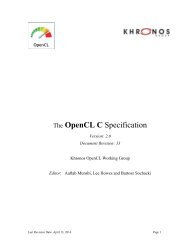
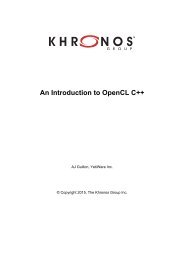
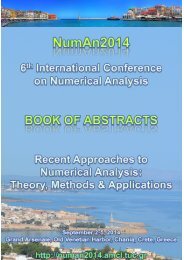
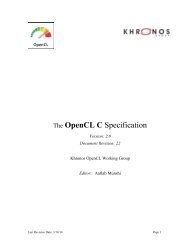

![arXiv:1305.1183v1 [cs.DC] 6 May 2013](https://img.yumpu.com/14598982/1/190x245/arxiv13051183v1-csdc-6-may-2013.jpg?quality=85)
